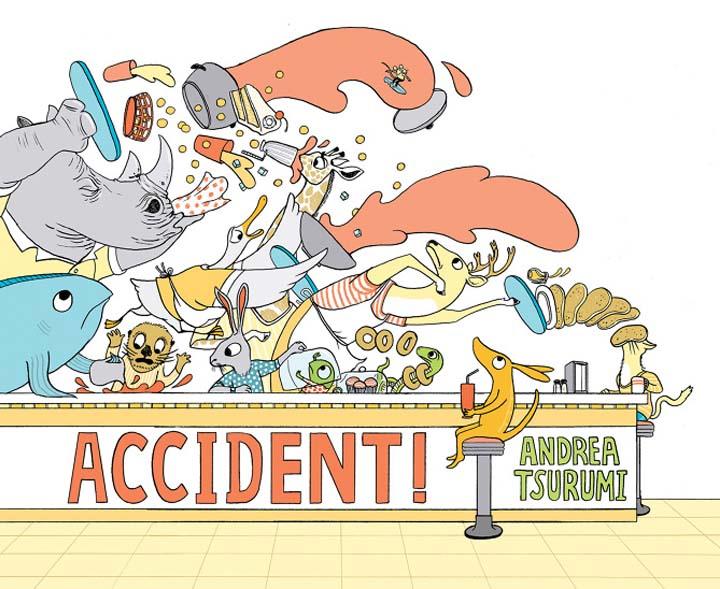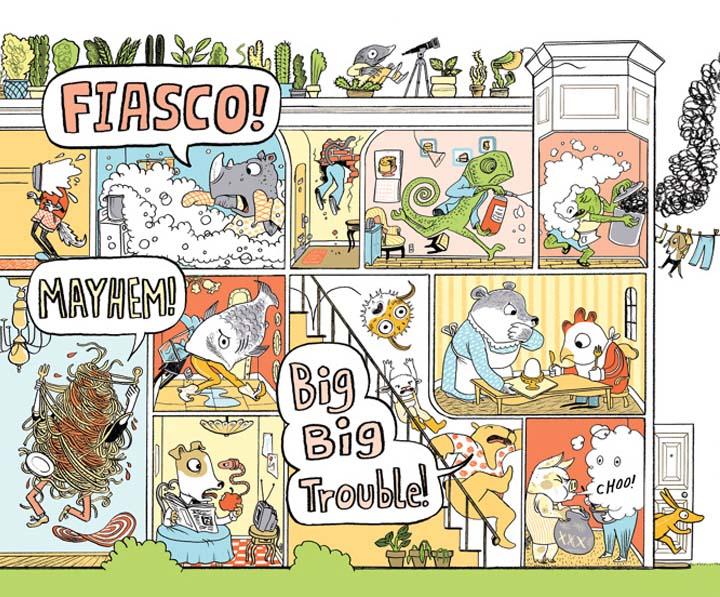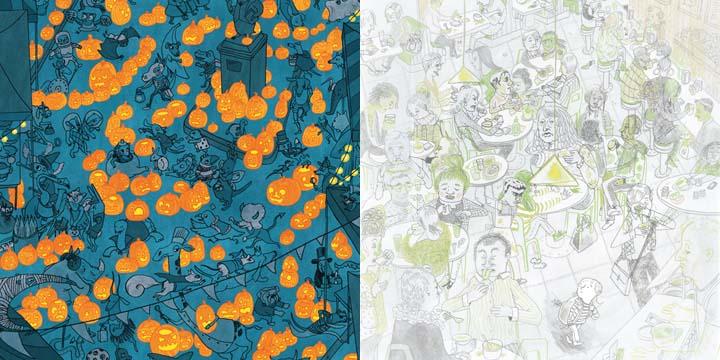The Q&A: Andrea Tsurumi
Q: Originally from New York, what are some of your favorite things about living and working in Philadelphia?
A: Philly's got loads of history, artists and museums, and lovely green spaces. It's got so many interesting things but even more crucially, it gives you room to enjoy and explore them. It's also a city with a sense of humor—the historic prison in our neighborhood throws a massive Bastille Day drag party where they throw Tastykakes off the battlements while blasting "Pour Some Sugar on Me.”
Q: Do you keep a sketchbook?
A: Yup! It's really important to me, although it took me a while to figure out you need to set aside time to do nothing and play in it.
What is the balance between art you create on paper [or other analog medium] versus in the computer?
Everything starts on paper and finishes in Photoshop.
Q: What is the most important item in your studio?
A: This might sound like a dodge, but really it's the studio itself. It's so fantastic to have a separate space just to work. It was important to learn that I can work anywhere and don't have to be comfortable to work, but it's so much nicer to have space for thinking things out.
Q: How do you know when the art is finished?
A: That's a hard question. Best I can say is if the work is doing what I hope it does and is not doing what I don't want it to do, and the only unanswered questions in it are ones I'm cool with leaving there. Also, depending on the deadline.
Q: What was your favorite book as a child?
A: Oh god, I don't have just one, but I can say that The Westing Game by Ellen Raskin and the Usborne Children's Encyclopedia by Jane Elliott and Colin King came with me to college and grad school and are now on my studio shelf out of the dog's reach.
What is the best book you’ve recently read?
You & A Bike & A Road by Eleanor Davis is incredible. I finished this book a little more in love with and alive to the world than when I started.
Q: If you had to choose
one medium to work in for an entire year, eliminating all others, what medium would you choose?
A: Pen and some watercolor wash so I could pick up a sketchbook and go.
Q: What elements of daily life exert the most influence on your work practice?
A: My day-to-day is structured around my deadlines, any classes I'm teaching, and helping my fiance take care of the household and our dog, Spatula. Artistically, my artist friends and colleagues are a huge support. I'm also constantly learning new things and getting new ideas from conversations with folks, books I'm reading, art I'm seeing online. A surprising amount of new ideas come from things I don't expect to find—overheard conversations, odd things I see, other people's preoccupations, joking around with friends, and the news.
Q: What was the [Thunderbolt] painting or drawing or film or otherwise that most affected your approach to art?
A: Instead of one big turning point, my experience has been more of a long path packed with different works and people and projects that have all brought me where I am now. There were certain aha! leveling moments, though. Growing up, I was just fed with stories and art—picture books, comics, movies, plays, museums, TV shows, art classes, hanging out with school librarians. So that I knew that I loved consuming all of this, but there was a moment in Mr. Mounkhall's 10th grade English class (where we were doing a lot of writing and he let us take turns telling stories at the end of the week) where something clicked and I realized I wanted to make stories too. Of course I had no idea how to do this and struggled with lots of preconceived ideas about what stories I was supposed to tell (see Ira Glass's Gap advice) until going to SVA's Illustration as Visual Essay MFA program. Meeting and working with the other students, learning about Joann Sfar, Lewis Trondheim, Eleanor Davis, and Brecht Evens and doing the thesis with Nick Bertozzi broke down these assumptions I had about what comics and illustration were and showed me how to turn toward the types of stories I cared about.

A: Appropriately, I stumbled onto my first picture book, Accident, by accident. A friend, illustrator Nina Frenkel, gave me that prompt during a drawing jam game and I made a silly image that my agent, Stephen Barr, thought could be a great book idea. I wasn't sure, but then exploring and expanding it brought out so many ideas for jokes and ridiculousness and also a message about accidents that I wished I'd taken to heart as a kid. Working on this book taught me so much about navigating between working loosely (play, surprise) and tightly (editing, re-editing).
Q: What would be your last supper?
A: Oh man, these are my favorites but they sound terrible together:
Lamb Malai Methi, Rice, Earl Grey tea, clam chowder, garlic string beans, sourdough bread, mochi ice cream and Andes mints.
Andrea Tsurumi is an illustrator and cartoonist from New York who now lives and draws in Philadelphia. A
lifelong book nerd, she received an English BA from Harvard and an MFA in illustration from the School of Visual Arts. Her work has been included in the Best American Comics notables list and received
a silver medal from the Society of Illustrators. Her clients include Penguin Random House, Bloomsbury Books, SpongeBob Comics, the Boston Globe, the Nib, and the Philadelphia Museum of Art. Books
she's illustrated include Girls Who Code, and The Friendship Riddle. Her first picture book, Accident!, was released at the beginning of October, from Houghton Mifflin
Harcourt
andreatsurumi.com
instagram: @atsurumi
twitter: @andreatsurumi
Represented by Stephen Barr | Writers House





